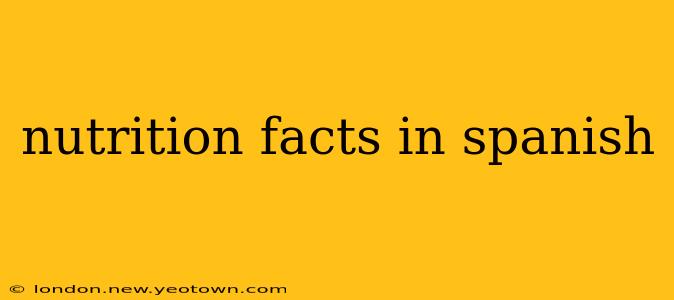Navigating nutrition labels can be tricky, even in your native language. But what about when you're facing a package in Spanish? This guide will demystify Spanish nutrition facts, helping you make informed choices at the grocery store and beyond. Let's embark on this culinary adventure together!
¿Qué información debo buscar en una etiqueta nutricional en español?
Spanish nutrition labels, like their English counterparts, aim to provide a clear picture of a food's nutritional content. They usually follow a standardized format, although minor variations might exist depending on the country of origin (Spain, Mexico, Argentina, etc.). The key information you'll find includes:
-
Tamaño de la porción (Serving Size): This indicates the amount of food the nutritional information refers to. Pay close attention to this, as the values are per serving. A larger serving size will naturally mean higher calorie and nutrient counts.
-
Cantidad por porción (Amount Per Serving): This section breaks down the nutritional components per serving. You'll typically see:
- Energía (Energy or Calories): The total energy content in kilocalories (kcal).
- Grasas totales (Total Fat): Includes saturated, unsaturated, and trans fats. Understanding the breakdown of fats is crucial, as saturated and trans fats should be limited.
- Grasas saturadas (Saturated Fat): A type of fat linked to increased cholesterol levels.
- Grasas trans (Trans Fat): Generally considered unhealthy and should be avoided as much as possible.
- Colesterol (Cholesterol): Found mainly in animal products.
- Sodio (Sodium): Excessive sodium intake can contribute to high blood pressure.
- Carbohidratos totales (Total Carbohydrate): Includes sugars, starch, and fiber.
- Azúcares (Sugars): Added sugars should be consumed in moderation.
- Fibra dietética (Dietary Fiber): Important for digestive health.
- Proteínas (Protein): Essential for building and repairing tissues.
- Vitamina A, C, etc. (Vitamins A, C, etc.): Essential vitamins and minerals, often expressed as a percentage of the recommended daily intake (%VD or %VR).
- Hierro (Iron): An important mineral for oxygen transport.
- Calcio (Calcium): Crucial for bone health.
¿Cómo entiendo los porcentajes del valor diario (%VD or %VR)?
The "%VD" (porcentaje del valor diario) or "%VR" (porcentaje del valor recomendado) indicates the percentage of the recommended daily intake of a nutrient contained in one serving. A higher percentage doesn't automatically mean "better," but it helps you understand how that serving contributes to your overall daily needs.
¿Qué significan las diferentes partes de la tabla nutricional?
This section goes into more detail about the different sections of the table and what to focus on.
Grasas: ¿Qué tipo de grasas debo evitar?
Focus on limiting saturated and trans fats. Look for foods with low levels of these. Unsaturated fats are generally considered healthier.
Azúcares: ¿Cómo identifico los azúcares añadidos?
Added sugars are not always explicitly listed but are often hidden within various ingredients. Be wary of products with high sugar content, even if it isn't directly stated as "added sugar."
Sodio: ¿Cuánta cantidad de sodio es demasiado?
A high sodium intake is linked to cardiovascular problems. Opt for lower-sodium options whenever possible.
¿Existen diferencias entre las etiquetas nutricionales en diferentes países de habla hispana?
While the basic structure is similar, minor variations might occur depending on the country. The terminology might slightly differ, but the core information remains consistent. Pay attention to any specific guidelines or regulations mentioned on the label itself.
¿Dónde puedo encontrar más información sobre la lectura de etiquetas nutricionales en español?
Many government health websites and reputable nutrition organizations offer resources in Spanish to help you navigate nutrition labels effectively. A quick online search for "etiquetas nutricionales en español" will yield various helpful resources.
By understanding the key terms and components of Spanish nutrition facts, you can make more informed and healthier choices for yourself and your family. Happy eating!

